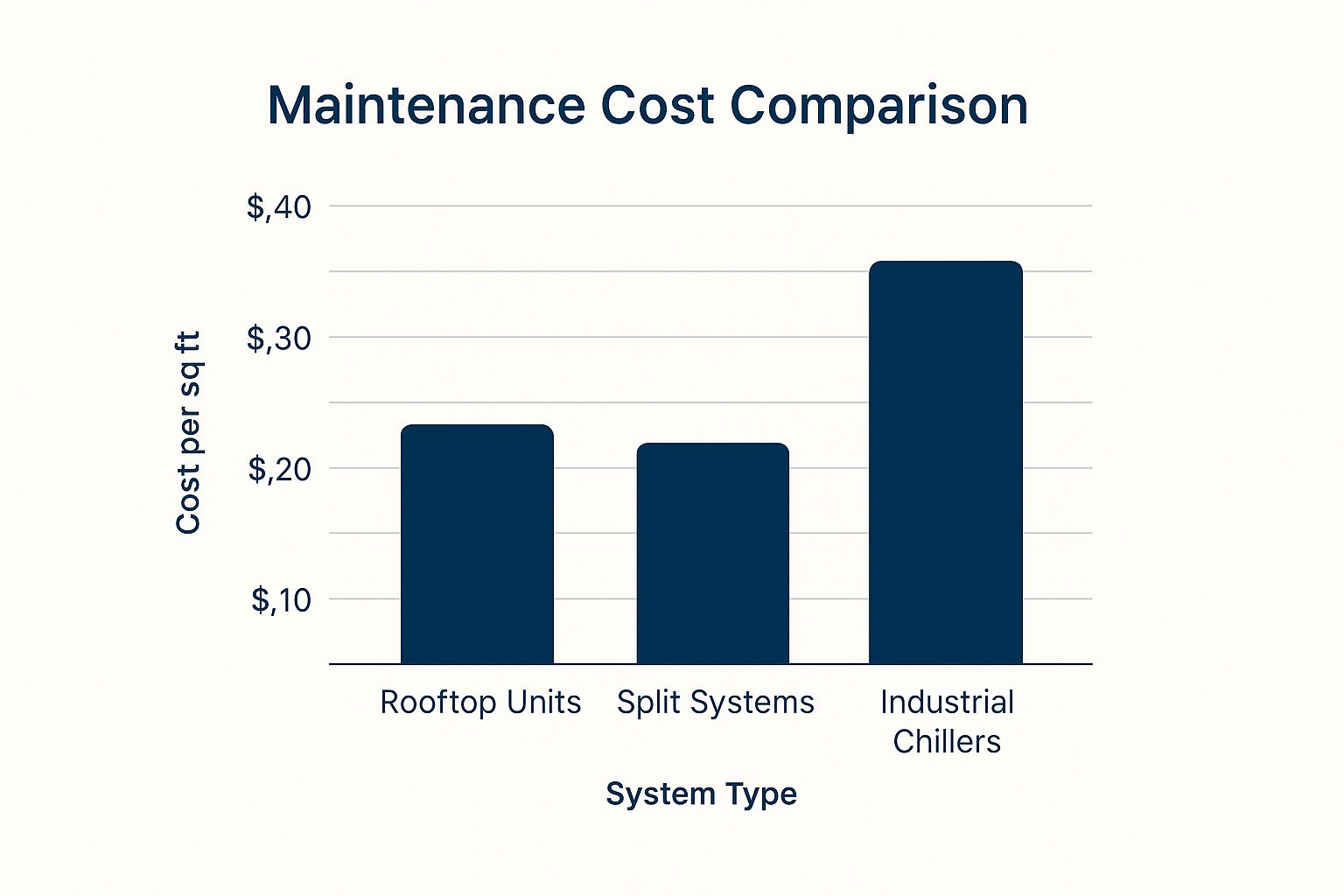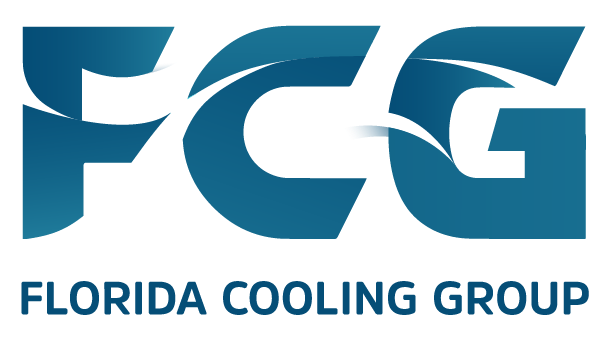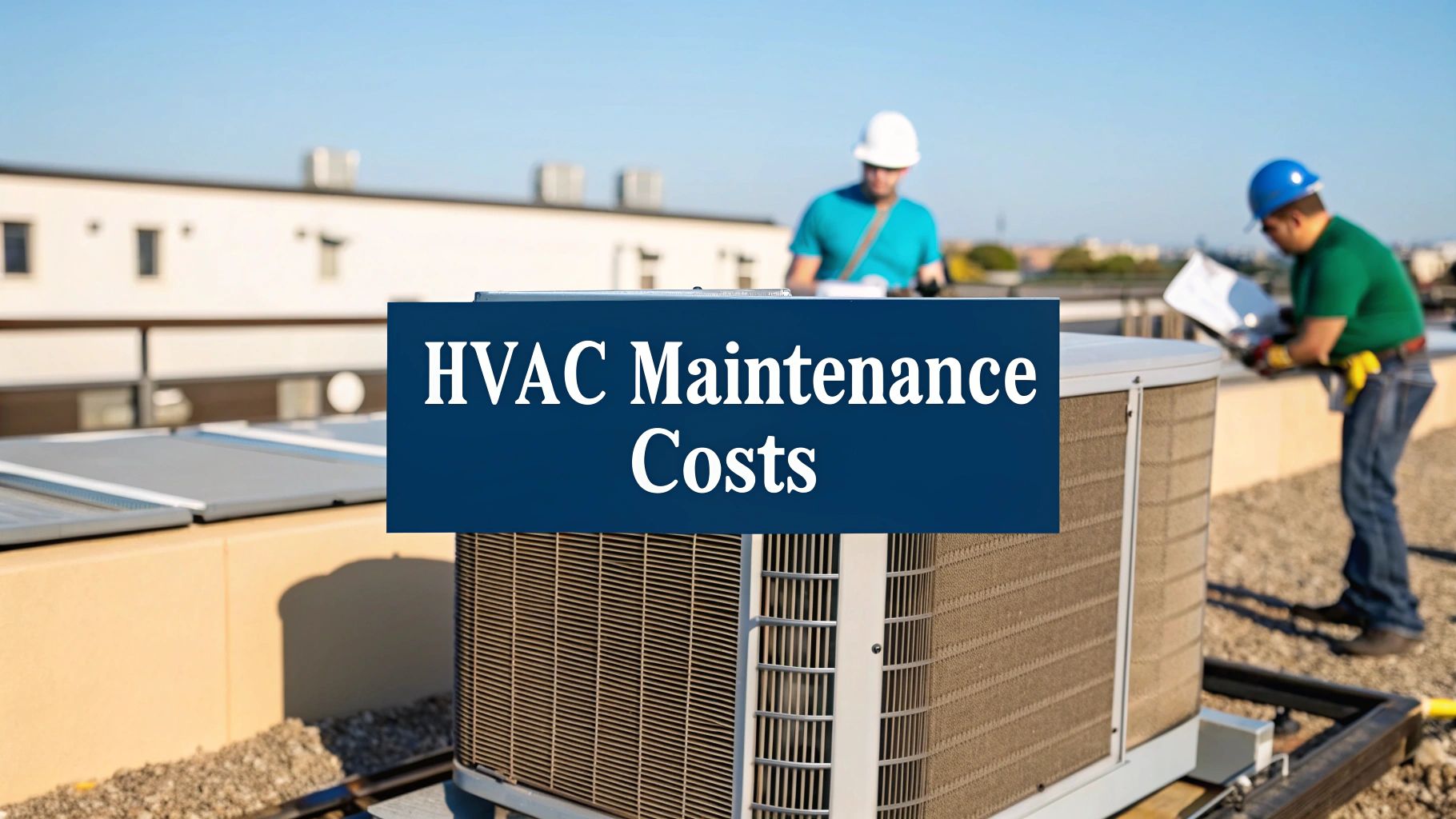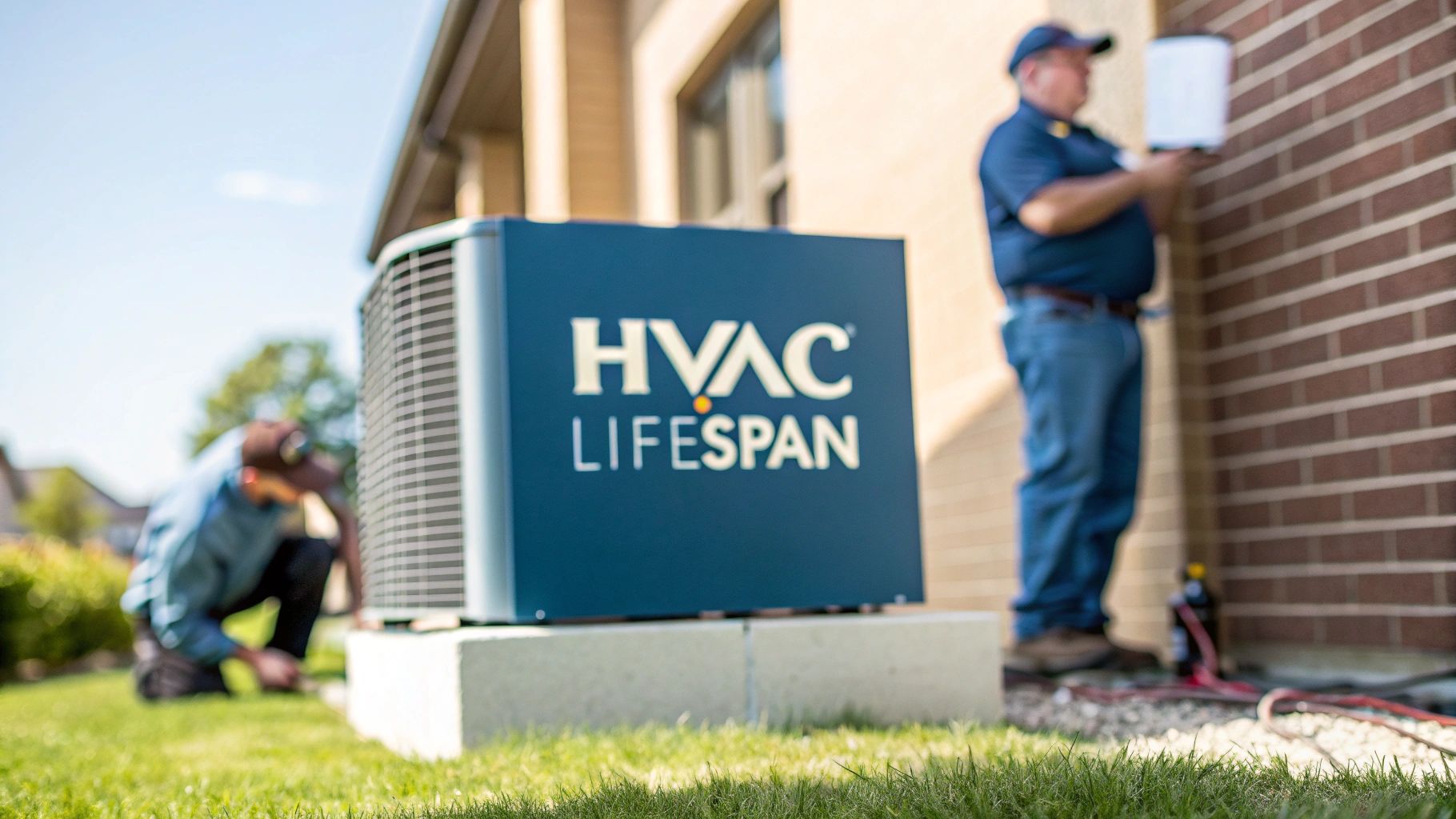When you look at the numbers, commercial HVAC maintenance costs can seem all over the map, ranging from $500 a year to well over $200,000. It's a huge spread. A small retail shop with a single rooftop unit might land on the lower end, while a sprawling industrial facility with a complex network of systems will naturally be on the higher side.
But here’s the thing: it’s a mistake to view this cost as just another bill to pay. It’s an investment in keeping your business running smoothly.
Understanding Your HVAC Maintenance Investment
Think about your HVAC system like you would a fleet of company vehicles. You wouldn't skip oil changes and tire rotations and just hope for the best, right? Doing that would inevitably lead to a van breaking down on the side of the road, disrupting deliveries and costing a fortune in emergency repairs.
The same logic applies directly to your building's heating and cooling systems. Routine, professional service is what stands between you and a catastrophic failure on the hottest day of the year. It's about preventing problems, not just reacting to them.
Without it, you're rolling the dice. A system that should last 14 years might give out after just nine, forcing you into a massive, unplanned replacement. When you see maintenance as a way to protect your equipment and your budget, the perspective shifts from a short-term expense to a smart, long-term business strategy.
A Snapshot of Common Maintenance Plans
So, what are you actually paying for? The cost really boils down to how much work is included and how much risk you want to offload to your service provider. More comprehensive plans cost more upfront but can save you a bundle on unexpected repair bills down the line.
Let's break down what some typical agreements look like.
Here's a quick look at common commercial HVAC maintenance plans, what they usually include, and what you can expect to pay.
Typical Commercial HVAC Maintenance Plan Costs
| Plan Type | Typical Services Included | Estimated Annual Cost Range |
|---|---|---|
| Basic Preventative Plan | Quarterly filter changes, visual inspections, cleaning around air intakes, checking electrical connections. | $500 – $5,000 |
| Standard Comprehensive Plan | Includes all basic services plus coil cleaning, belt and pulley checks, refrigerant level monitoring, and drain line clearing. | $5,000 – $25,000 |
| Full-Service Contract | Covers all preventative tasks plus labor for most repairs, priority emergency service, and sometimes includes parts. | $25,000 – $200,000+ |
Think of this table as a starting point. Your final quote will always depend on the specifics of your building and equipment, which is exactly what we’ll dive into next.
What Goes Into Your HVAC Maintenance Price?

When you get a quote for commercial HVAC maintenance, that final number isn't just pulled out of thin air. It’s a carefully calculated figure that ties directly to the time, labor, and specific expertise needed to keep your system humming along.
Think of it like getting an insurance quote. You wouldn’t expect to pay the same premium for a small sedan as you would for a massive semi-truck. The risk, complexity, and potential replacement costs are worlds apart. The exact same logic applies to your HVAC system.
Getting a handle on these factors is key. It puts you in the driver's seat, allowing you to have smarter conversations with contractors and budget accurately for what your building actually needs.
System Size and Complexity
The single biggest factor driving your maintenance cost is the scale and intricacy of your HVAC equipment. A little café with a single 10-ton unit on the roof is a completely different ballgame than a hospital running a massive network of industrial chillers and air handlers tied into a sophisticated building automation system.
More equipment doesn’t just mean more time on site. It means more moving parts to check, more filters to change, and more complex diagnostics. A sophisticated setup like a Variable Refrigerant Flow (VRF) system, for example, requires technicians with specialized training, which naturally comes at a higher rate.
This is exactly why there’s no such thing as a one-size-fits-all price in this business. The scope of your operation directly sets the scope of the maintenance work.
Age and Condition of Your Equipment
How old your system is and how well it's been cared for are also huge pieces of the pricing puzzle. A shiny new system that's still under warranty usually just needs straightforward preventative checks to keep it running at peak performance. The work is predictable and routine.
On the other hand, an older unit that's been ignored for years is going to need a lot more elbow grease. Caked-on grime, worn-out belts, and potential refrigerant leaks all take significant time and effort to fix. An aging system is also a lot more likely to have parts on their last legs, which adds replacement costs to the service ticket.
A poorly maintained 20-ton rooftop AC unit might give up the ghost after just nine years. But with proper care, that same unit can easily hit its expected 14-year lifespan—or even go beyond it. That difference is a massive saving in the long run.
This is why sticking to a consistent maintenance schedule is so important. It’s always cheaper to pay for regular cleanings and minor tweaks than it is to foot the bill for an emergency repair after a catastrophic failure.
The Specific Tasks on the Checklist
The services actually included in your maintenance plan have a direct impact on the price. Not all plans are created equal, and the tasks can range from simple to highly technical.
Here are a few common services and how they affect the cost:
- Filter Changes: This is the most basic task, but it’s non-negotiable for system health. The cost depends on the filter type—from simple cardboard filters to high-end, specialized media.
- Coil Cleaning: Dirty coils are energy hogs. Cleaning them is labor-intensive but absolutely essential for efficiency. You can get a deeper look at what's involved in our guide on the cost of cleaning an evaporator coil.
- Refrigerant Checks: Low refrigerant levels kill your cooling power and can damage the compressor. This check requires certified technicians and specialized tools.
- Mechanical Inspections: Looking over belts, motors, and other moving parts for wear and tear is what helps you catch big problems before they happen.
Staying on top of this stuff is how you keep your energy bills in check and avoid those dreaded surprise breakdowns. In fact, a well-maintained HVAC system can cut energy consumption by up to 20%, a major win for any business's bottom line.
Navigating Commercial HVAC Service Agreements
Trying to pick a commercial HVAC service agreement can feel a lot like deciphering a legal document. The terms sound the same, but the fine print reveals huge differences in what's covered and what you'll pay. Getting a handle on these agreements is the first step to truly controlling your HVAC maintenance costs and protecting your business from surprise expenses.
Think of it like car insurance. You can get basic liability to cover the bare minimum, or you can go for a full-coverage policy that handles almost anything that could go wrong. Neither is a bad choice; it all comes down to your budget and how much risk you're comfortable with.
Comparing Common Service Agreements
When you start getting quotes, you'll likely run into two main options: Preventative Maintenance Agreements (PMAs) and Full-Service Contracts. A PMA is the more basic package, focused on keeping your system running smoothly with regular tune-ups. It’s all about preventing problems before they have a chance to start.
A Full-Service Contract, as the name implies, is the all-inclusive option. It covers all the preventative stuff, but it also usually includes the cost of labor and even parts for most repairs. With this kind of deal, you're essentially handing off the financial risk to your service provider.
To make things clearer, let's break down what you get with each type of plan. This table gives you a quick at-a-glance comparison of the most common HVAC maintenance contracts, so you can see how they stack up.
Comparing Commercial HVAC Service Contracts
| Contract Type | What It Covers | Best For | Cost Structure |
|---|---|---|---|
| Preventative Maintenance Agreement (PMA) | Scheduled inspections, filter changes, coil cleaning, and basic system checks. Repairs and parts are extra. | Newer systems, businesses on a tight budget, or facilities with in-house maintenance staff for minor fixes. | Lower, fixed fee for scheduled visits. Variable costs for any repairs needed. |
| Full-Service Contract | All preventative maintenance tasks plus labor and parts for most repairs. Exclusions are specified. | Older systems, businesses that need predictable costs, and mission-critical facilities where downtime is costly. | Higher, all-inclusive fixed fee. Covers most unexpected repair costs, providing budget certainty. |
| Labor-Only Agreement | Covers the cost of labor for any repairs needed during the contract period. Parts are an additional cost. | Businesses that can source their own parts or want to control parts spending, but want to cap labor expenses. | Moderate fixed fee. Protects against high labor bills but not the cost of expensive components. |
Ultimately, the goal is to find a contract that aligns with your specific equipment and business needs, turning a reactive, unpredictable expense into a planned, manageable one.
Preventative Maintenance Agreements (PMAs)
A Preventative Maintenance Agreement is the absolute bedrock of smart HVAC care. It’s a straightforward plan where a technician comes out on a regular schedule to perform routine tasks that keep your system healthy.
So, what's usually in a PMA?
- Regular Inspections: Scheduled visits, typically quarterly or semi-annually, to give your system a full check-up.
- Filter Changes: Swapping out old air filters to keep air flowing freely and cleanly.
- Component Cleaning: Scrubbing essential parts like condenser and evaporator coils to keep them running efficiently.
- Basic Calibrations: Fine-tuning thermostat settings and tightening up electrical connections.
These plans are a great fit for facilities with newer equipment or for businesses that need to keep a close eye on their budget. Just remember, if the technician finds a problem during a visit, the cost to repair it and any parts needed will be billed separately. For a closer look at what goes into these visits, our guide on professional AC maintenance services gets into the nitty-gritty.
Full-Service Contracts
A Full-Service Contract is the premium choice, designed to give you total peace of mind with a predictable, fixed annual cost. Yes, the upfront price is higher, but it’s your shield against those sudden, gut-wrenching repair bills that can wreck a budget.
This kind of agreement is a must-have for businesses where HVAC failure is simply not an option. Think medical facilities, data centers, or busy retail stores. A single day of downtime in those places could easily cost more than the entire annual service contract.
The type of equipment you have plays a huge role in which contract makes sense. This chart breaks down how much maintenance costs can differ.

As you can see, the more complex the system—like an industrial chiller—the higher the maintenance cost per square foot. This is where a comprehensive service agreement really starts to look like a smart investment. The right contract doesn't just buy you service; it buys you predictability.
The True Cost of Neglecting HVAC Maintenance

It’s easy to look at a maintenance plan as just another line item on the budget. That’s a huge mistake. The real commercial hvac maintenance cost isn't what you pay for the service—it's what you risk by skipping it. Trying to save a few hundred dollars today can leave your business wide open to a full-blown, wallet-crushing disaster down the road.
Picture a busy retail shop in the peak of a Florida summer heatwave. The AC unit, which hasn't been looked at in over a year, suddenly dies. The store gets hot, fast. Customers walk out, and the emergency repair bill alone is going to sting. But that's just the tip of the iceberg.
That one breakdown sets off a chain reaction of financial hits that make any "savings" from skipping maintenance look tiny in comparison.
The Ripple Effect of a System Failure
When your HVAC system goes down, the emergency repair fee is just the start. The real pain comes from all the secondary problems that throw your entire operation into chaos. A single day of unexpected downtime can be brutally expensive.
Here’s a quick look at how fast the costs can pile up:
- Lost Revenue: Nobody wants to shop or eat in a sweltering building. For any customer-facing business, that means an instant drop in sales. Productivity also plummets when employees are miserable.
- Damaged Reputation: A hot, sticky experience leaves a bad taste. Customers might not come back, and a few negative online reviews can scare away new business for months.
- Inventory Loss: If you run a restaurant, grocery store, or even a flower shop, a busted cooling system can mean throwing out thousands of dollars in spoiled products.
These operational losses often add up to far more than the repair bill itself, which is exactly why getting ahead of problems is so important.
Long-Term Financial Consequences
Beyond the immediate crisis, a neglected system silently drains your bank account. A poorly maintained unit is an inefficient one. It has to work much harder to do its job, which means your energy bills are going to creep up month after month.
But the biggest hit by far is premature equipment replacement. A commercial HVAC unit that’s well taken care of can easily last 14 years or more. One that's ignored might completely fail in as little as nine years, forcing you into a massive, unplanned purchase.
There's a reason commercial maintenance contracts are so common. Smart businesses have figured out that proactive care is always cheaper in the long run. In fact, the industry is even evolving, with some plans now using technology for real-time monitoring to catch issues before they become emergencies.
Ultimately, the best financial move you can make is investing in consistent, professional upkeep. Understanding how regular maintenance extends your AC’s lifespan is the first step toward protecting your equipment and keeping your business running smoothly without those costly surprises.
Practical Strategies to Reduce Your HVAC Costs

Knowing what drives your commercial HVAC maintenance cost is the first step. The real win, though, is figuring out how to lower those costs without letting your system’s health slide. The good news is, you have a lot more control over this than you might think.
A smart approach combines simple, everyday habits with a few bigger strategic moves. Think of it like getting better gas mileage in your car—small things like keeping your tires properly inflated and not flooring it at every green light really add up over time. The same logic applies here; consistent, small efforts can lead to big savings on both maintenance and energy bills down the road.
Start with Simple In-House Tasks
You don't need a toolbox and a certification to make a difference. In fact, some of the most effective ways to prevent expensive service calls can be handled by your own on-site staff. These are the basics, the first line of defense that keeps small problems from turning into budget-breaking disasters.
Here are a few high-impact tasks your team can easily manage:
-
Consistent Filter Changes: This is the lowest-hanging fruit. When filters get clogged with dust and grime, they choke the system's airflow, forcing it to work overtime just to keep up. Check them monthly and make sure they’re replaced at least quarterly.
-
Keep Units Clear: Take a walk around your property. Are the outdoor condenser units buried in leaves or blocked by overgrown shrubs? Are indoor vents obstructed? Clear airflow is critical for efficiency, and blockages put a huge strain on the equipment.
-
Monitor System Performance: Train your staff to be your eyes and ears. If they hear a strange new rattling sound, smell something odd coming from the vents, or notice one area is suddenly much colder than another, they should report it right away. Catching these red flags early can be the difference between a minor fix and a catastrophic failure.
Make Smart Strategic Investments
Beyond the daily grind, a few well-placed investments can yield major savings. These moves might require some upfront spending, but they pay for themselves by cutting down on wear and tear, boosting efficiency, and giving you more leverage when it's time to negotiate.
Upgrading to modern, programmable thermostats alone can reduce heating and cooling costs by 10% to 20% annually. This technology prevents unnecessary operation during off-hours, directly cutting down on wear and tear.
Look into these strategic options:
-
Install Smart Thermostats: These devices let you automate your heating and cooling schedules around when people are actually in the building. Why pay to climate-control an empty office overnight or on a weekend? Less runtime means less strain on your system.
-
Bundle Services: Do you have multiple properties or need other facility services like plumbing or electrical? Talk to your providers about bundling. Many companies will cut you a deal for a larger, all-inclusive contract.
-
Always Get Multiple Quotes: Never just go with the first quote you receive for a maintenance contract. Get at least three detailed bids. This gives you a much clearer picture of what the market rate is and puts you in a much stronger position to negotiate a better deal.
By weaving these practical, everyday tasks into your routine and making smarter long-term decisions, you can get a real handle on your maintenance budget. It's all about being proactive, keeping your system running smoothly, and making sure your operational costs stay predictable.
How Technology Is Reshaping HVAC Maintenance Costs
The future of HVAC service isn't some far-off concept anymore—it's already here, and it’s all about data. For years, maintenance has been about sticking to a rigid schedule. But new tech is making service smarter, more precise, and in the long run, much easier on your budget. It's time to rethink what goes into your commercial HVAC maintenance cost.
Innovations like Internet of Things (IoT) sensors and AI-powered predictive maintenance are completely changing the game. Think of it this way: your modern car doesn't just ask for an oil change at 5,000 miles. It tells you it's time based on how you actually drive. HVAC systems can now do the exact same thing.
These smart sensors are always on, keeping an eye on things like vibration, temperature, and energy consumption. They feed this constant stream of data into a system that uses AI to catch tiny anomalies—the subtle clues that a part is about to fail, long before it actually breaks. This shifts your maintenance strategy from being reactive to being proactive and data-driven.
The Rise of Predictive Maintenance
Predictive maintenance is all about fixing a problem before it becomes a real headache. Instead of having a technician find a worn-out belt during a routine quarterly check, the system can flag it for replacement weeks ahead of time. The long-term savings here are huge.
By catching potential failures early, you can schedule repairs during off-hours, avoid the chaos of unexpected downtime, and stop a small issue from snowballing into a massive, expensive component replacement. It’s the key to maximizing efficiency and getting more life out of your equipment.
It's no surprise that the market for these kinds of advanced services is blowing up. Projections show the global HVAC maintenance and repair service market growing from $150 billion in 2025 to around $260 billion by 2033. This boom is fueled by two things: aging buildings and the wide adoption of smarter maintenance tech. You can learn more about the evolving HVAC service market from Archive Market Research.
While a tech-forward maintenance plan might look different on paper, the return on investment is undeniable. You're not just paying for service; you're protecting your building's most critical systems. So, when you're talking to a potential provider, be sure to ask them about their technology and how they actually use data to keep your system running smoothly.
Frequently Asked Questions
When it comes to commercial HVAC maintenance, a few questions pop up time and time again. Let's clear the air and give you straightforward answers to the most common concerns business owners face.
Why Can’t I Just Fix My HVAC System When It Breaks?
It’s a tempting thought—why pay for maintenance when the system is running fine? But waiting for a breakdown, often called a "run-to-failure" approach, is almost always the most expensive way to manage your HVAC. Think of it like only changing your car's oil after the engine seizes up.
Emergency service calls come at a premium, especially after hours or on a weekend. More than that, sudden downtime can paralyze your business. You're left dealing with lost sales, unproductive employees, unhappy customers, and in some cases, even ruined inventory.
Proactive maintenance is your best defense. It's not just about preventing expensive surprise repairs; it's about keeping your energy bills low, extending the life of your equipment, and protecting the massive investment you've already made in your facility's comfort.
What Should a Basic Commercial HVAC Maintenance Contract Include?
While no two contracts are identical, any solid preventative maintenance plan should cover the fundamentals. You should expect scheduled service visits, typically two to four times a year, timed to prepare your system for the upcoming heating or cooling season.
During these visits, a certified technician should perform a core checklist of tasks:
- Thorough Inspections: A deep dive into all critical heating and cooling components.
- Filter Changes: Essential for clean air and preventing system strain.
- Cleaning: Clearing coils, drain lines, and outdoor unit components of debris.
- System Checks: Verifying refrigerant levels, tightening electrical connections, and lubricating moving parts.
A good contract is transparent. It will clearly list every included task and spell out any extra costs for parts or labor that fall outside the plan, helping you accurately budget your commercial hvac maintenance cost.
How Does Building Size Affect Maintenance Costs?
The cost of a maintenance plan is directly tied to the scale and complexity of your HVAC system. It’s a simple matter of time, equipment, and expertise.
A small retail shop with a single rooftop unit is a relatively simple job, and its maintenance agreement might only be a few hundred dollars a year.
On the other hand, a large office building with multiple chillers, dozens of air handlers, and a sophisticated building automation system is a different beast entirely. Maintaining a system like that requires significantly more technician time and specialized knowledge, so a contract could easily run into the tens of thousands annually. The price reflects the number of units, their total capacity (tonnage), and the hours needed to do the job right.
Ready to take the guesswork out of your HVAC costs? The experts at Florida Cooling Group are here to design a maintenance plan that fits your facility’s unique needs and budget. Protect your investment and ensure year-round comfort by visiting Florida Cooling Group's website to schedule a consultation today.

 (561) 400-2205
(561) 400-2205

